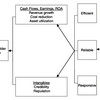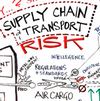 Today’s unstable and highly competitive business environment has created a shift in how enterprises are established and managed, where past “traditional” enterprises are replaced by new “virtual” enterprises, forming temporary networks of independent companies or Virtual Enterprise Networks (VENs) that share skills, costs and access to each other’s market. I am currently writing a book chapter for the book Managing Risk in Virtual Enterprise Networks: Implementing Supply Chain Principles
Today’s unstable and highly competitive business environment has created a shift in how enterprises are established and managed, where past “traditional” enterprises are replaced by new “virtual” enterprises, forming temporary networks of independent companies or Virtual Enterprise Networks (VENs) that share skills, costs and access to each other’s market. I am currently writing a book chapter for the book Managing Risk in Virtual Enterprise Networks: Implementing Supply Chain Principles, which is about risks in Virtual Enterprise Networks (VENs), and here are some the ideas that have come to my mind when trying to connect risks in supply chains with risks in VENs.
What is a VEN?
Thompson (2008) defines a VEN as “a voluntary and dynamic community of Small and Medium Enterprises that commit to working together for a set period of time, to collectively seek opportunities to participate in collaborative projects of mutual business interest”. A VEN is by definition a time-limited structure; it has a set life-cycle, i.e. the duration of a project in which the participating enterprises partake. This life cycle perspective poses certain challenges in how to manage VEN risks, as they may change from project to project.
Drivers of Supply Chain Vulnerability vis-à-vis Drivers of VEN Vulnerability
The view of a supply chain network that comes closest to a VEN is that of Peck (2005), where the “chain” is not a chain, but a complex web or network of interlinked businesses. Here, this network is seen as operating on four levels, where the links within one level may not match the links within the other levels:
At level 1, the supply chain is seen as a logistics pipeline, where the focus on lean and agile practices have made supply chain performance the overall goal but at the same time it also exposed the supply chain to many risks. At level 2 the focus is on the supply chain as a carrier of goods and information, and supply chain vulnerability is determined by production sites, distribution centers and warehouses, as well as IT and other communication facilities, and also the whole transportation network from supplier to end customer. At level 3 the view is further afield, looking at the supply chain from a strategic and management perspective, where organizational management, power-sharing, collaboration and competition become important factors in evaluating vulnerability. At level 4 the view is a broad macroeconomic perspective, political, economic, social, legal and technological factors, and disruptions or sudden changes in these factors are more often than not beyond the control of the company, but must be dealt with accordingly.
The 4-level model employed by Peck is easily transferable to a VEN environment and is an excellent tool for explaining the scope and dynamic nature of supply chain risk. It emphasizes that a resilient network involves much more than the design and management of robust supply chain processes. It is also important to recognize that by taking actions to reduce risk at one point within the four levels, at the same time the risk profile for the other levels is changed, including players and stakeholders not thought of in the initial risk assessment. Supply chains are dynamic and constantly evolving, and so is supply chain risk, and managing this risk is a constant battle and a never-ending process. A VEN is by definition a time-limited structure; it has a set life-cycle, i.e. the duration of a project in which the participating enterprises partake. In a VEN, where the players are constantly changing, the risk is constantly changing, too.
VEN risk management vis-à-vis Business Continuity Management
A VEN is a collaboration rather than a competition, a collective effort rather than a set of individual efforts, and hence, the underlying idea of a VEN is that it is a win-win undertaking. Nonetheless, in today’s global and interwoven business environment, where supply chain disruptions can occur more or less frequently, the subsequent failure of one contributing participant in the supply network (or chain) can potentially lead to the collapse of the whole network (or chain). In a VEN environment, win-win turns into loose-loose, and consequently, the term business continuity management should be explored and related to VEN continuity management.
Strategies for managing VEN risks
Robustness, flexibility, and resilience stand out as three strategies or approaches towards supply chain disruptions. These three terms are distinctively different and which strategy that works best would depend not only on the supply chain in question as a whole, but also which part of the supply chain that may be vulnerable. A best-practice supply chain is likely to encompass all three, making it robust, flexible and resilient at the same time. There is a distinct notion of severity in these definitions, and in a business setting, the ability to survive (resilience) is likely to be much more important than the ability to quickly regain stability (robustness) or the ability to divert (flexibility). While on the supply chain side resilience may be the right way forward, on the VEN side it is more likely to be agility, that should take priority, since essentially VENs are agile by nature. Agility in supply chains is a concept that is explored by for instance Christopher and Peck (2004).
Resilience as a key ingredient for managing VEN risks
A good illustration of where the susceptibility to disruption (and hence, the resilience and ability to recover) is a determining variable in the strength of a supply chain can be seen in a report from the New Zealand research initiative “Resilient Organisations” (Mc Manus, 2007). Here, resilience is a 3-fold construct, depending on 1) keystone vulnerabilities, 2) situation awareness and 3) adaptive capacity. The adaptive capacity becomes particular important in recovering from a disruption. In a supply chain this could be viewed as the the inter- and intra-organizational “preparedness” (or worst case, “un-preparedness”). It is the preparedness then that determines the actual impact of supply chain disruptions. However, supply chain resilience is not only a function of organizational preparedness; it is also a function of supply chain design, as in Craighead et al. (2007).
Supply chain vulnerability and VEN vulnerability
There is no one definition of supply chain vulnerability, and it is likewise difficult to make one definition of VEN vulnerability, but the closest definition is probably found in McManus (2007), where vulnerability is a function of the impact of a disruption and the organizational preparedness towards the disruption.
VEN characteristics as disruption impact parameters
The notion that both structural and organizational supply chain characteristics play a major role in supply chain disruptions is further underscored in Craighead et al. (2007), where the severity of supply chain disruptions is related to supply chain design characteristics (supply chain density, supply chain complexity and node criticality) and supply chain mitigation capabilities (recovery capability and warning capability). In brief: supply chain structure and supply chain organization.
These factors are presented in the form of 6 propositions: Firstly, proposition 1 to 3, an unplanned event that disrupts a supply chain is more likely have a severe impact if the supply chain structure is 1) dense or 2) complex or 3) contains critical nodes or bottlenecks. Secondly, proposition 4 and 5, an unplanned event that disrupts a supply chain is less likely have a severe impact if the supply chain 4) has proactive or reactive recovery capabilities or 5) warning capabilities, as in detection and dissemination of critical information. Thirdly, proposition 6, combining the previous 5 propositions, an unplanned event disrupting a supply chain that is dense, complex and with many critical nodes is less likely to be severe if there is a capability to quickly detect and disseminate information about the event and thus respond and correct in a proactive or reactive manner.
It appears then that propositions 4, 5 and 6 are inherent to VENs, due to their collective and collaborative structure, and VENs should fare better vis-à-vis disruptions compared to traditional supply chains.
Conclusion
Supply chains are competitive, VENs are collaborative. Approaching VENs from a supply chain perspective can assist in defining the risks and challenges a VEN faces and how to manage them, particularly since many of the traditional supply chain risks stem from a lack of collaboration and visibility, the hallmarks of VENs, making VENs the ideal setup for supply chains and making supply chain risk management a fertile ground for researching VEN risk management.
Selected Key References
Christopher, M. (2005) Managing risk in the supply chain. In: Christopher, M. (Ed.) Logistics and Supply Chain Management. 3rd ed., Prentice Hall, pp. 231-258.
Christopher, M. and Peck, H. (2004) Building the Resilient Supply Chain. The International Journal of Logistics Management. Vol. 15, No. 2, pp. 1 – 14.
Craighead, C. W., Blackhurst, J., Rungtusanatham, M. J. & Handfield, R. B. (2007) The Severity of Supply Chain Disruptions: Design Characteristics and Mitigation Capabilities. Decision Sciences, Vol. 38, No. 1, pp. 131-156.
Mc Manus, S. et al (2007) Resilience Management – A Framework for Assessing and Improving the Resilience of Organisations. Research Report 2007/01, Resilient Organisations, New Zealand. www.resorgs.org.nz
Peck, H. (2005) Drivers of supply chain vulnerability: an integrated framework. International Journal of Physical Distribution & Logistics Management, Vol. 35, No. 3/4, pp. 210-229.
Thompson, K. (2008) The Networked Enterprise. Meghan-Kiffer Press.
Related
- husdal.com: Risks in Virtual Enterprise Networks












